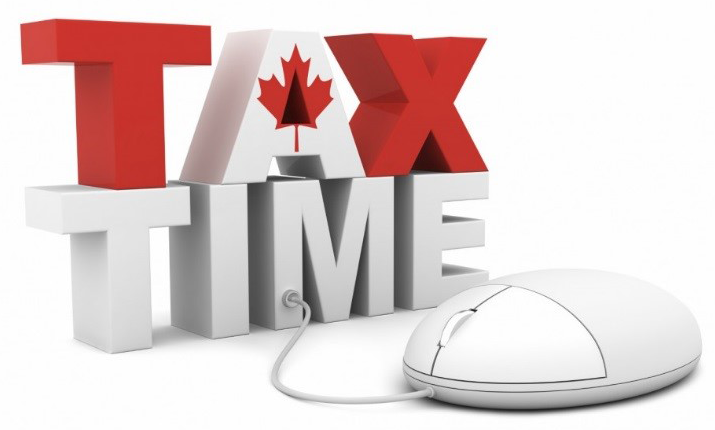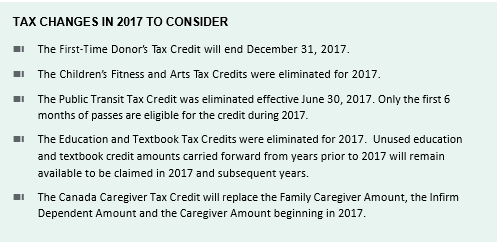
As December 31st is quickly approaching, now is the time to look at tax plans that needs to be implemented prior to year-end. The following is a list of tax tips for you to keep in mind.
PAY TAX-DEDUCTIBLE OR TAX-CREDITABLE EXPENSES BEFORE YEAR-END
A variety of expenses can only be claimed as a tax deduction or tax credit on your tax return if the amount is paid by the end of the calendar year. If the intention is to pay a tax-deductible or tax-creditable expense early next year, consider paying the amount by the end of this year in order to get the benefit of the tax deduction or tax credit on this year's tax return.
Examples of tax-deductible expenses include interest, carrying charges, and employment related car expenses. Examples of tax-creditable expenses include medical expenditures and charitable donations.
ARE YOU TURNING 71 THIS YEAR?
If you will be 71 by the end of this year, you must terminate your Registered Retirement Savings Plan (RRSP) no later than December 31st. There are several options available: transferring your RRSP to a Registered Retirement Income Fund (RRIF), purchasing an annuity, receiving a lump sum or choosing a combination of these options.
If you have not maximized RRSP contributions in previous years and have unused contribution room, you can make a lump sum contribution before closing your RRSP. Once your final contribution is made, the deductions can be used in any future year, whenever they are most beneficial for you in reducing taxable earnings.
If however you have no carry-forward RRSP contribution room but have earned income in the year you turn 71, you'll have RRSP contribution room next year but no RRSP. You may want to consider making next year's contribution in December of this year, just before your required conversion date. The penalty for the over-contribution will only be one per cent for the month. However, on January 1st, your over contribution disappears, and you'll get a tax deduction on next year's tax return or whenever you choose to claim it.
ARE YOU OVER AGE 71?
Regardless of your age, if you have qualifying earned income or unused RRSP contribution room and your spouse1 is age 71 or younger, you can contribute to a spousal RRSP prior to December 31st of the year your spouse turns 71 and claim the deduction on your tax return whenever it is most advantageous to you. This strategy is particularly attractive if you anticipate your spouse's retirement income will be lower than yours.
FIRST-TIME HOMEBUYERS
If you are thinking about buying your first home and are planning to take advantage of the Home Buyers' Plan (HBP), you may wish to delay your RRSP withdrawal under the HBP until January. Under the plan, you may take up to $25,000 from your RRSP without penalty provided you repay the funds over a 15-year period. These repayments must begin two years after the initial withdrawal. Since the repayment schedule is calculated according to the calendar year, if you wait and make your withdrawal in January instead of December, you can delay your first repayment for one more year.
REALIZE CAPITAL LOSSES
Consider realizing capital losses before year end. A capital loss must be deducted against any capital gain in the current year and the excess, if any, may be carried back three years or carried forward indefinitely in order to reduce a taxable capital gain reported at that time.
DELAY CAPITAL GAINS
If you plan on rebalancing your portfolio or selling an investment with accrued capital gains, consider delaying until January of next year (to the extent they cannot be offset by realized capital losses).
TFSA WITHDRAWALS
If you are considering a withdrawal from your Tax Free Savings Account (TFSA), the timing of the withdrawal is important. Withdrawals from a TFSA are not taxable, but keep in mind that amounts withdrawn from your TFSA are not added to your TFSA contribution room until the beginning of the calendar year following the withdrawal. Consider withdrawing from your TFSA before year end instead of early next year.
RESPs – ELIGIBILITY FOR CESG
In order to receive the CESG after age 15, the following contributions must have been made to the RESP (and not withdrawn) by December 31st of the calendar year in which the child or grandchild turns 15:
- Total contributions of at least $2,000, or
- Contributions of at least $100 a year or more in any four previous years.
If your child or grandchild turns 15 this year, by December 31st of this year, you must have either contributed at least $2,000 in total to the child's RESPs, or you must have put in at least $100 annually in any of four previous years (they don't have to be consecutive years).
RRSPs – WITHDRAW IN LOW INCOME YEARS
If your income will be unusually low this year, consider making an RRSP withdrawal by December 31st. This strategy would generally only make sense if you are in the lowest tax bracket and would end up losing available tax deductions and tax credits.
Also keep in mind that once you have made a withdrawal from your RRSP, this contribution room is lost and contributions can only be made to the extent that you have available RRSP contribution room in the future.
PENSION INCOME CREDIT
If you are 65 or older and receive eligible pension income, you are entitled to deduct from your taxes payable, a federal tax credit equal to 15 per cent on the first $2,000 of pension income received plus the provincial tax credit2.
If you don't currently receive pension income you may want to consider withdrawing $2,000 from a RRIF per year. This strategy can also work where you use RRSP funds and purchase an annuity paying at least $2,000 per year.
Also note that the interest income from an insurance company Guaranteed Interest Contract (GIC), or the interest element of a non-registered annuity contract also qualifies for the pension income credit at age 65 or older. For more information, see Tax Managed Strategy #14 – The pension income tax credit using an insurance company GIC (MK2071).
PENSION INCOME SPLITTING
Spouses are allowed to split eligible pension income with their spouse. This can result in a reduction of family taxes and can also minimize the impact on income-tested tax credits and benefits. If you have a spouse who is in a lower tax bracket, you and your spouse will be able to elect to have up to 50 per cent of eligible income transferred to the lower income spouse. Eligible income is defined as income eligible for the pension income credit.
While this is a joint election that can be made when filing your and your spouse's tax returns, another consideration to make before year end is whether additional amounts should be withdrawn from your RRIF in order to split with your spouse. Keep in mind that only 50 per cent of the additional amount received can be split, so the remainder of those RRIF withdrawals will be taxed in your hands.

With all of the celebrations and gatherings that will quickly fill up your December calendar, don't make the mistake of waiting until January or you will be missing valuable opportunities. CALL US NOW so that we can review options that will maximize your contributions and minimize your tax responsibilities. For your convenience we can set up a time to meet, schedule a Skype or Conference call to best fit your schedule.
1 Includes a spouse or common-law partner as defined by the Income Tax Act (Canada).
2 The tax credit is calculated at the lowest federal and provincial/territorial tax rates. The amount of pension income eligible for the provincial/territorial tax credit varies.
The commentary in this publication is for general information only and should not be considered investment or tax advice to any party. Individuals should seek the advice of professionals to ensure that any action taken with respect to this information is appropriate to their specific situation. Manulife, the Block Design, the Four Cube Design, and Strong Reliable Trustworthy Forward-thinking are trademarks of The Manufacturers Life Insurance Company and are used by it, and by its affiliates under license. MK3515E 10/17

